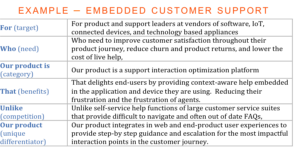- Introduction – Company Stage – Culture – Lean Canvas
- Positioning Framework: Segmentation – Personas – Point of View
- Elevator Pitch – Solution – Discovery and Qualification – Sales deck – Roadmap – Enablement
Elevator pitch
This classic template from Geoffrey Moore’s Crossing the Chasm forces us to get very clear about target customers, pain point addressed, category, value, competition, and differentiation. This is a must do. You would not use verbatim what you put in the pitch – it’s too long and not conversational, but it gives you the ingredients with which you can create differentiated compelling value statements.
An actual pitch might look like this:
| Self-Support in a sentence: | Guided and context aware self-support that results in higher customer satisfaction, lower volume of agent sessions, and increased brand loyalty. Embedded in mobile apps, websites, and connected device user experience. |
| Value prop for vendors: | Eliminate customer frustration and improve satisfaction by augmenting your current support investments with embedded, guided experiences for the most impactful customer interactions. |
Solution description with feature/benefits
This section of the positioning framework defines how we talk about our solution in a consistent way and what capabilities we want to highlight. It is important to start with the values for our key target audience, then tie them to our core capabilities and why they are important.
In this example for embedded customer support, we wanted to highlight the value for both the vendors and for their customers. We identified three top values for each and then listed the four features and their relevance.
Having this defined ensures that everybody talks about the solution in the same way and avoids the proliferation of different feature lists that dilute the message and confuse the audience.
Prospect discovery and qualification
To better prepare sales it is super useful to identify the typical prospect profiles, their pains, and their journey. This functions as a template against which sales can navigate their discovery process and qualify the opportunity while establishing themselves as credible experts and business partners.
Different profiles may be determined by factors such as industry type, size of company, level of maturity. For example, in cloud management systems, a high-tech company that was born in the cloud is very different from an enterprise in the process of migrating workloads to the cloud. While the first one is most likely to have deep devops skills and cloud knowledge, an enterprise may be further behind and need much more education.
So each profile type will have different stakeholders, pains, current system, driving events, compelling reason to buy, alternative solutions, and buying process.
Being familiar with these profiles, gives sales reps a solid list of probing questions to ask that show they understand their customers’ reality, have been there before, and can help them in their journey.
- Company profile type
- Industry
- Stakeholders
- Pain
- Value proposition
- Current system
- Alternatives
- Compelling event
- Buying process
- Open-ended probing questions
- Short slide deck
If a company story cannot be told in ten slides or less, it’s the wrong story.
Many sales decks are filled with indefensible statements and endless product features slides. How much credibility do you have stating that you are the “Leader in category X” when all the other vendors in the category claim the same? Listing a bunch of features in hope that a few will resonate only positions you for a feature poker fight with your competitors. Don’t get me wrong: features are important, but customer loyalty is much stronger when customers are not just buying features, but also share a vision, a journey that they believe matches where they want to go.
10 slides max – identify with the customer journey and demonstrate leadership
- Build relationship – we understand your pain, we speak your language
- Frame it in the context of a big, relevant vision – we are on a mission – we may not have all the features yet, but we know our path
- Differentiate the solution – what we do and how it’s different/better
- Build credibility, prove the value – how is your life going to be better – what have customers similar to you achieved
- Call for action
- Product strategy and roadmap
Aligning value proposition and vision to product priorities. It is amazingly powerful when everybody in an organization is aligned to the same vision, and is executing on the same plan. Conversely, it is so confusing and disruptive when marketing and sales tell one story, and engineering is building something different.
- Work closely with the product team (product managers and engineering)
- Keep priorities in line with strategy
- Focus on solving the identified pain points
- Pick one key area where you will be better than anybody else
- Be relentless about user experience
- Only focus on the features that let you validate your current hypothesis
- Use prototypes to get quick and early feedback
- Be clear on what metrics you are tracking to decide where to go next
- Enablement and Execution
But wait: you are not done yet. Don’t let all this effort go to waste by keeping it an isolated exercise. Socialize it and train everybody in the company on the new strategy and message. It lends great credibility and confidence when all contacts with a vendor reinforce the same vision and message. From the website, to blog posts, to sales, professional services, support, and engineering.
- Enable sales and everybody in the company
- Collaborate with marketing to create killer demand gen programs and content
- Adjust and pivot based on lessons learned
- Always stay close to the customers!


Leave a Reply